Phenology refers to the sequential developmental stages, also called growth stages, that may occur in perennial plants every season. The growth stages of blueberry plants are affected by temperature, light intensity, and light duration (photoperiod). Erratic weather can impact the plant’s developmental phases. For example, warmer temperatures tend to speed up growth while the opposite occurs with cooler temperatures. Identifying blueberry growth stages allows producers to implement adequate management practices to secure the future crop.
The different types of cultivated blueberries—northern highbush (Vaccinium corymbosum L.), southern highbush (Vaccinium corymbosum interspecific hybrids), lowbush (Vaccinium angustifolium Ait), and rabbiteye (Vaccinium virgutam Ait)—all possess a similar response to temperature, light levels, and photoperiod. In general, short daytime photoperiods induce flower bud initiation and temperatures higher than 84.4 °F in the fall inhibit it. Yield is directly related to flower bud initiation and differentiation. Therefore, growers must identify and differentiate flower buds from vegetative buds and understand their functions in order to apply the best practices from planting to harvesting.
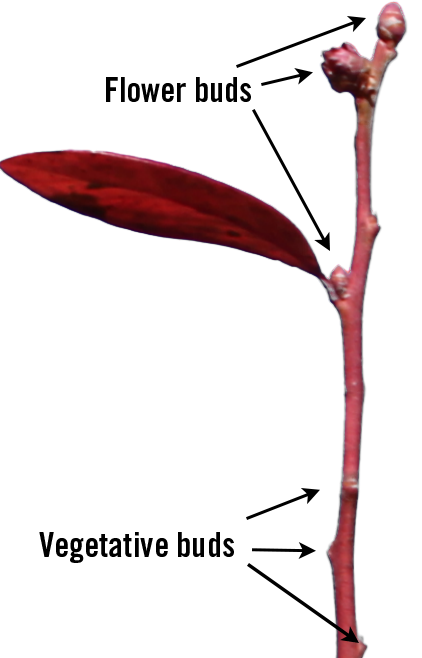
Identifying Flower Buds
Flower buds (Figure 1):
- usually are located on the upper part of the shoot;
- develop on 1-year-old wood or current season’s growth;
- only produce the flower-like clusters, not leaves;
- are larger than the pointed vegetative buds;
- develop last on upright growth that develops after postharvest pruning; and
- are visible on the tips of last year’s growth shoots (laterals).
Identifying Vegetative Buds
Vegetative buds (Figure 1):
- are located further down the growth shoot just above the node where the petiole meets the stem (leaf axil);
- are smaller, scale-like, and approximately 0.15 in. long;
- develop along the stem; there is one bud for each leaf that is produced;
- will produce a new shoot and leaves; and
- are formed from axillary growing points (called meristems) the previous year.
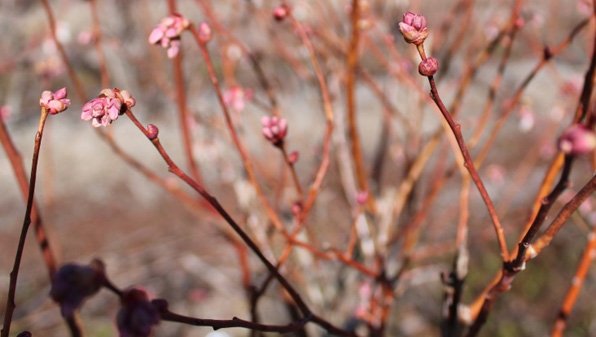
Typically, buds swell before either leaves (or flowers) appear. The appearance of green between the brown bud scale is indicative of bud break. Vegetative bud break occurs after flower bud break (Figure 3). Vegetative buds are future shoots with stems and leaves. Vegetative buds contain up to six small developing leaves. Leaves are the plant’s main photosynthetic organs and sense changes in day length. Thus, leaves influence flower bud initiation and differentiation. Premature defoliation in the fall reduces the number of flower buds and should be avoided.
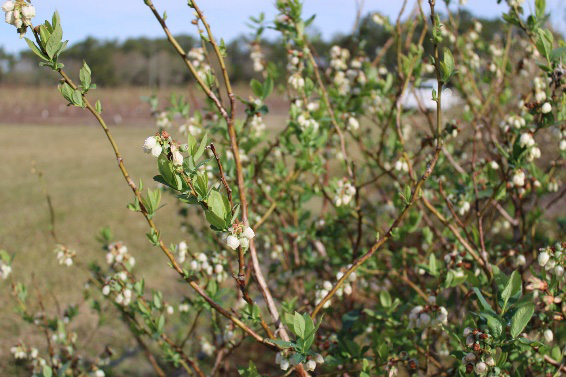
The ratio of flower buds to vegetative buds in blueberries is related to shoot diameter. Thick and thin shoots have more vegetative buds while medium-thickness shoots have more flower buds than vegetative buds.
Flower Bud Initiation
Flower bud initiation (FBI) is when a vegetative bud changes into a flower bud. The transition of a vegetative bud into a flower bud is controlled by biochemical processes triggered by day length and temperature. As days shorten and temperature decreases, vegetative buds located at the tops of the stems initiate their transition into flower buds. Blueberries start FBI during the late summer (August) through early fall (October). The precise time depends on weather, cultivar, and production management practices.
Flower Bud Differentiation
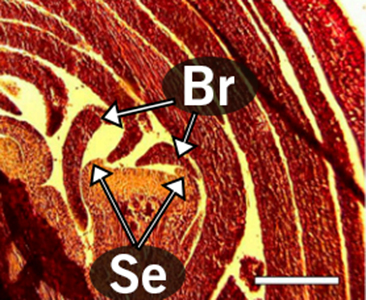
Photo from “Inflorescence bud initiation development and bloom in two southern highbush blueberry cultivars,” by A. P. Kovaleski, J. G. Williamson, J. W. Olmstead, and R. L. Darnell, 2015, J. Amer. Soc. Hort. Sci., 140(1), p. 40 (https://doi.org/10.21273/JASHS.140.1.38). Copyright 2015 by the American Society for Horticultural Science.
FBI is recognizable by a flattened apical meristem (Figure 4). Inside an individual apical meristem, bud differentiation starts from the bottom toward the top (e.g., from the most differentiated cells to the least). At the whole-plant level, flower bud differentiation (FBD) happens first in the top (distal) portion of the stems, shoots, or canes. In the southeastern highbush varieties, FBD continues throughout the winter unlike in the northern highbush varieties. After all the parts of the flower (sepals, petals, anthers, and ovary) are formed at the end of FBD, the buds swell (Figure 5) and enter dormancy.
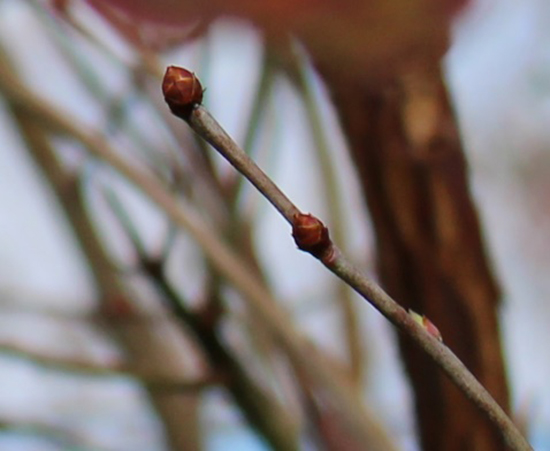
In general, the timing and extent of FBI or FBD influences the bloom dates the following spring. Cultivars that initiate FBI and FBD early also bloom early and are more likely to be damaged by a spring freeze. It is important to note that cultivars that initiate flower bud formation during fall can be negatively impacted by early defoliation. Therefore, we recommend maintaining appropriate spray applications to control leaf spot.
References
Childers, N. F., & Lyrene, P. M. (2006). Blueberries for growers, gardeners, and promoters. Norman F. Childers Horticultural Publications.
Kovaleski, A. P., Williamson, J. G., Olmstead, J. W., & Darnell, R. L. (2015). Inflorescence bud initiation, development, and bloom in two southern highbush blueberry cultivars. J. Amer. Soc. Hort. Sci., 140(1), 38–44. https://doi.org/10.21273/JASHS.140.1.38
Polashock, J. J., Carusso, F. L., Averill, A. L., & Schilder, A. C. (2017). Compendium of blueberry, cranberry, and lingonberry diseases and pests (2nd ed.). The American Phytopathological Society. https://doi.org/10.1094/9780890545386
Retamales, J. B., & Hancock, J. F. (2018). Blueberries (2nd ed.). CABI. https://doi.org/10.1079/9781780647265.0000
Status and Revision History
In Review on May 28, 2024
Published on Aug 21, 2024


























































